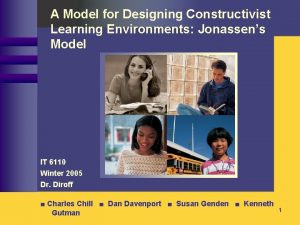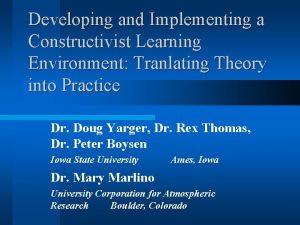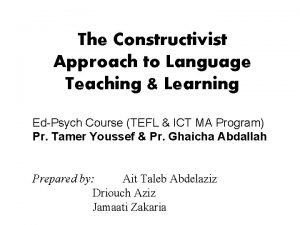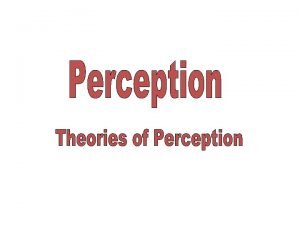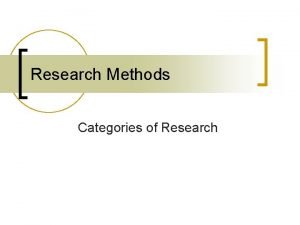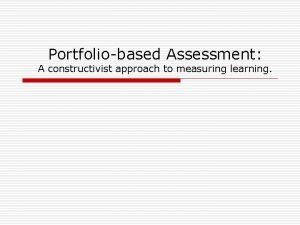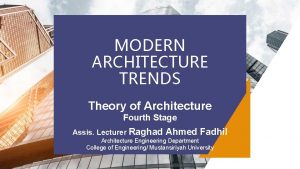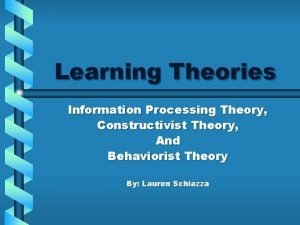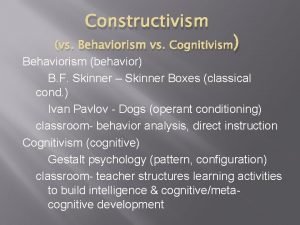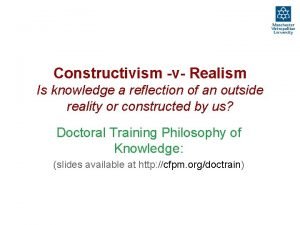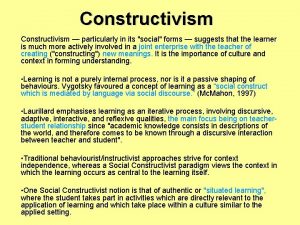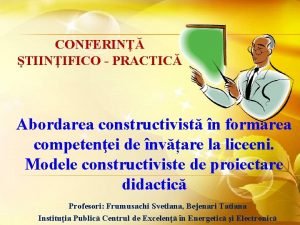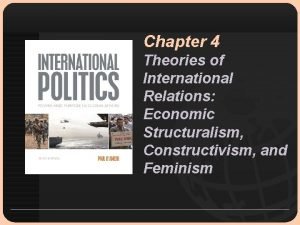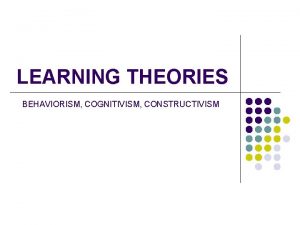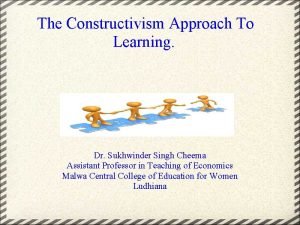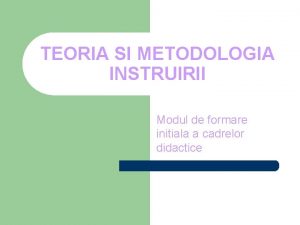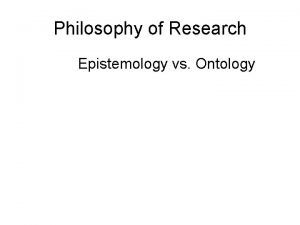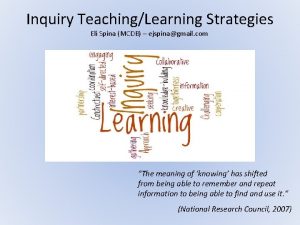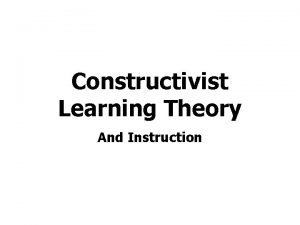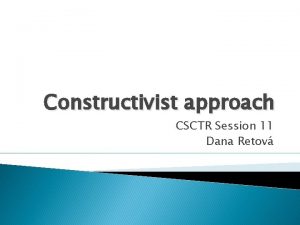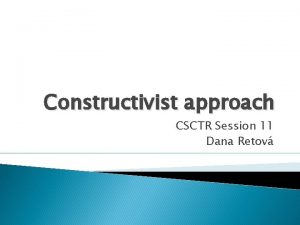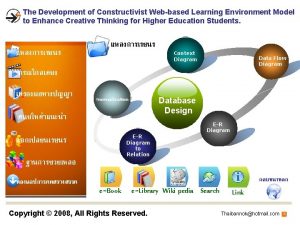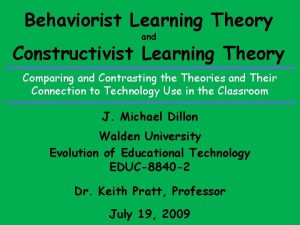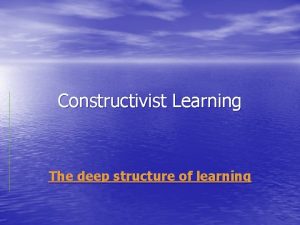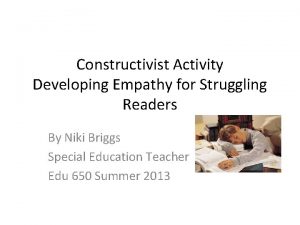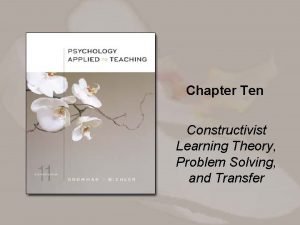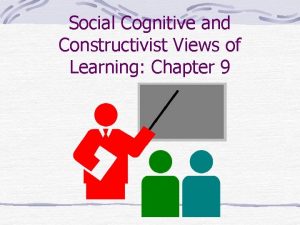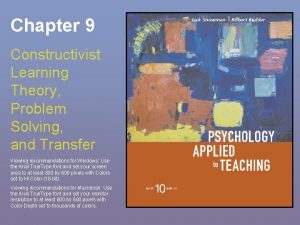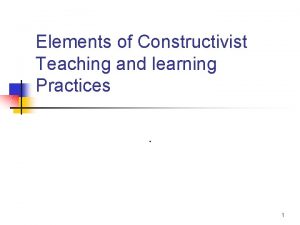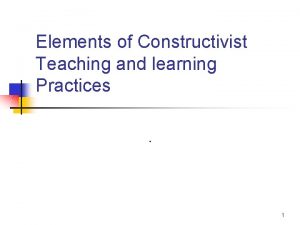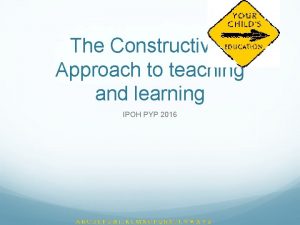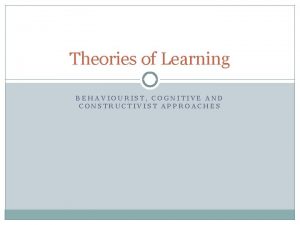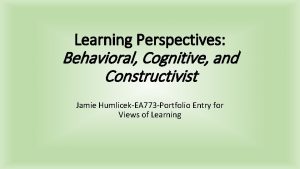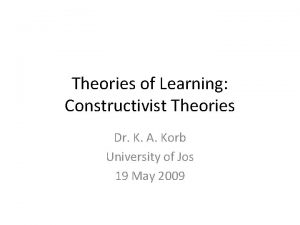Developing and Implementing a Constructivist Learning Environment Tranlating





































- Slides: 37

Developing and Implementing a Constructivist Learning Environment: Tranlating Theory into Practice Dr. Doug Yarger, Dr. Rex Thomas, Dr. Peter Boysen Iowa State University Ames, Iowa Dr. Mary Marlino University Corporation for Atmospheric Research Boulder, Colorado

Background For the past 30 years, education has been experiencing a revolution. l The goals of education have changed: – Memorization of facts is publicized as being less important than developing skills for problem solving and life long learning

Background For the past 30 years, education has been experiencing a revolution. l Our understanding of learning has increased: – Theory and evidence are favoring a knowledge construction model over the information transmission model

Background For the past 30 years, education has been experiencing a revolution. l Technology is increasing in capability and availability: – School computers are more common – Internet access is more widespread – Java has made instructional software more practical

Challenge l How can educators use the new knowledge about learning to realize the emerging goals of education for all class sizes and diverse and dispersed learners?

One approach l Employ greater integration of technology to better structure the learning experience and to provide management tools.

Role of Technology l Taxonomy of computer supported learning applications Exploration • Learner explores a model of the concept

Role of Technology l Taxonomy of computer supported learning applications Information • Learner receives information about a concept

Role of Technology l Taxonomy of computer supported learning applications Reinforcement • Learner practices using the concept

Role of Technology l Taxonomy of computer supported learning applications Integration • Learner applies concept in context

Role of Technology l Taxonomy of computer supported learning applications Utility • Learner uses computer applications to employ the concept

Example Unit: Adiabatic Processes ADIABATIC is a term for a process in which there is no net exchange of heat. Although adiabatic processes have no net heat change, this doesn’t mean that temperature is constant!!!!

An air parcel, like a balloon, expands as it moves upward in the atmosphere. Air parcel

It takes energy for the air molecules in the parcel to move the existing air molecules out of the way. Where does the energy come from? Air parcel

We know that it can’t be conduction or radiation from outside sources. These are too slow. What is left? Air parcel

Answer - From the air itself. When the parcel molecules push away the outside air they give up energy. So they slow down and air is cooler! Air parcel

Characteristics of adiabatic process l Essential to understanding the subject (fundamental concept)

Characteristics of special topics l Essential to understanding the subject (fundamental concept) l Foreign to learner (new concept)

Characteristics of special topics l Essential to understanding the subject (fundamental concept) l Foreign to learner (new concept) l Difficult to understand (complex)

Learning phases: Exploration l Mountain. Sim l Teacher’s role l Experience with student use of Mountain. Sim l Objectives

Learning phases: Exploration l Mountain. Sim

Learning phases: Exploration l Teacher’s role – What effects do mountains have? – Demo use of simulation – Assign simulation tasks

Learning phases: Exploration l Experiences with use of Mountain. Sim showed students: – used poor problem solving strategies – had weak learning strategies – asked shallow questions – were poor at making observations

Learning phases: Exploration l Objectives Task level Discipline level Metacognitive level

Learning phases: Exploration l Objectives Task level • Cause precipitation within target heights • Cause targeted temperature increases

Learning phases: Exploration l Objectives Discipline level • Understand the saturation curve • Understand adiabatic processes • Appreciate the effects of mountains on weather • Understand communication tools (e. g. , graphs)

Learning phases: Exploration l Objectives Metacognitive level • Identify the problem to be solved • Learn to control and test variables • Learn importance of accurate observation and recording • Learn role and importance of reflection

Learning phases: Information l Introduction to problem solving Classroom and Internet approaches

Learning phases: Information l Introduction to problem solving (Classroom) Students discuss in small groups what they learned and how they approached learning it (Internet)

Learning phases: Information l Introduction to problem solving (Classroom) Students discuss in small groups what they learned and how they approached learning it (Internet) Focused discussion groups address the same topics

Learning phases: Information l Information transfer (Classroom) Presentation of the physics of adiabatic processes, and the relationships between the graphs and the phenomena (Internet)

Learning phases: Information l Information transfer (Classroom) Presentation of the physics of adiabatic processes, and the relationships between the graphs and the phenomena (Internet) Various text, video and audio media address the same topics

Learning phases: Reinforcement l The concepts associated with air moving up a mountain can transferred to air moving over other air.

Learning phases: Integration l Weather forecasting Utility

Management Software l Forecasting submissions l Automated grading and records l Discussion groups l Simulation traces

Conclusions l Summary of activities – – l Exploration of the concept Information related to exploration Reinforcement of concepts Integration in authentic setting Why technology? – Stronger course objectives • Computer addresses low level objectives • Teacher can address higher level objectives – Individualized learning opportunities – Student directed

Conclusions l In the adiabatic unit we have demonstrated an application of modern learning theory to address the emerging goals of education. By using technology we have shown how this model can accommodate all class sizes and how it can be adapted for distance education.
 Designing constructivist learning environments
Designing constructivist learning environments Tranlating
Tranlating Constructivism teaching
Constructivism teaching Gregory's constructivist theory of perception
Gregory's constructivist theory of perception Post positivism
Post positivism Constructivist assessment examples
Constructivist assessment examples Constructivism architecture characteristics
Constructivism architecture characteristics Constructivist theory
Constructivist theory Attribution definition communication
Attribution definition communication Behaviorist vs constructivist
Behaviorist vs constructivist Constructivist vs realist
Constructivist vs realist Social constructivist meaning
Social constructivist meaning Dascal constructivist
Dascal constructivist Structuralism in international relations
Structuralism in international relations Theory of cognitivism
Theory of cognitivism Kathy charmaz constructivist grounded theory
Kathy charmaz constructivist grounded theory What is constructivism
What is constructivism Modelele instruirii
Modelele instruirii Ontological vs epistemological
Ontological vs epistemological Constructivist etymology
Constructivist etymology Cuadro comparativo e-learning y b-learning
Cuadro comparativo e-learning y b-learning Financial environment in business environment
Financial environment in business environment Chapter 7 strategic management
Chapter 7 strategic management Implementing strategies management and operations issues
Implementing strategies management and operations issues Chapter 7 strategic management
Chapter 7 strategic management The pricing tripod
The pricing tripod Toyota brand hierarchy
Toyota brand hierarchy Designing and implementing brand architecture strategies
Designing and implementing brand architecture strategies Planning and implementing crm projects
Planning and implementing crm projects Matching structure with strategy
Matching structure with strategy Low end entry level brand
Low end entry level brand Implementing strategies management and operations issues
Implementing strategies management and operations issues Implementing hrd programs pdf
Implementing hrd programs pdf Retail management notes doc
Retail management notes doc Learning principle in portfolio assessment
Learning principle in portfolio assessment Qsen competencies
Qsen competencies Challenges of implementing predictive analytics
Challenges of implementing predictive analytics Implementing organizational change spector
Implementing organizational change spector
